DZ Rules & FAQs
Info for Experienced Jumpers
Get The Deets!
Start Skydiving is a USPA Group Dropzone and Skydiving Center. Jumping with us means complying with all USPA and FAA rules, regulations, requirements, and recommendations. Check out our DZ rules and some of our FAQs below – and if you have other questions, give us a shout! We’re here to help.
General Rules
-
Use common sense and good judgment at all times
-
Treat others with courtesy and respect at all times.
-
Clean up after yourself. Hold others accountable for their messes, too.
-
Alcohol consumption is not permitted until the last load has departed. No exceptions!
-
No drugs are permitted on the airport at any time. Violators will be reported.
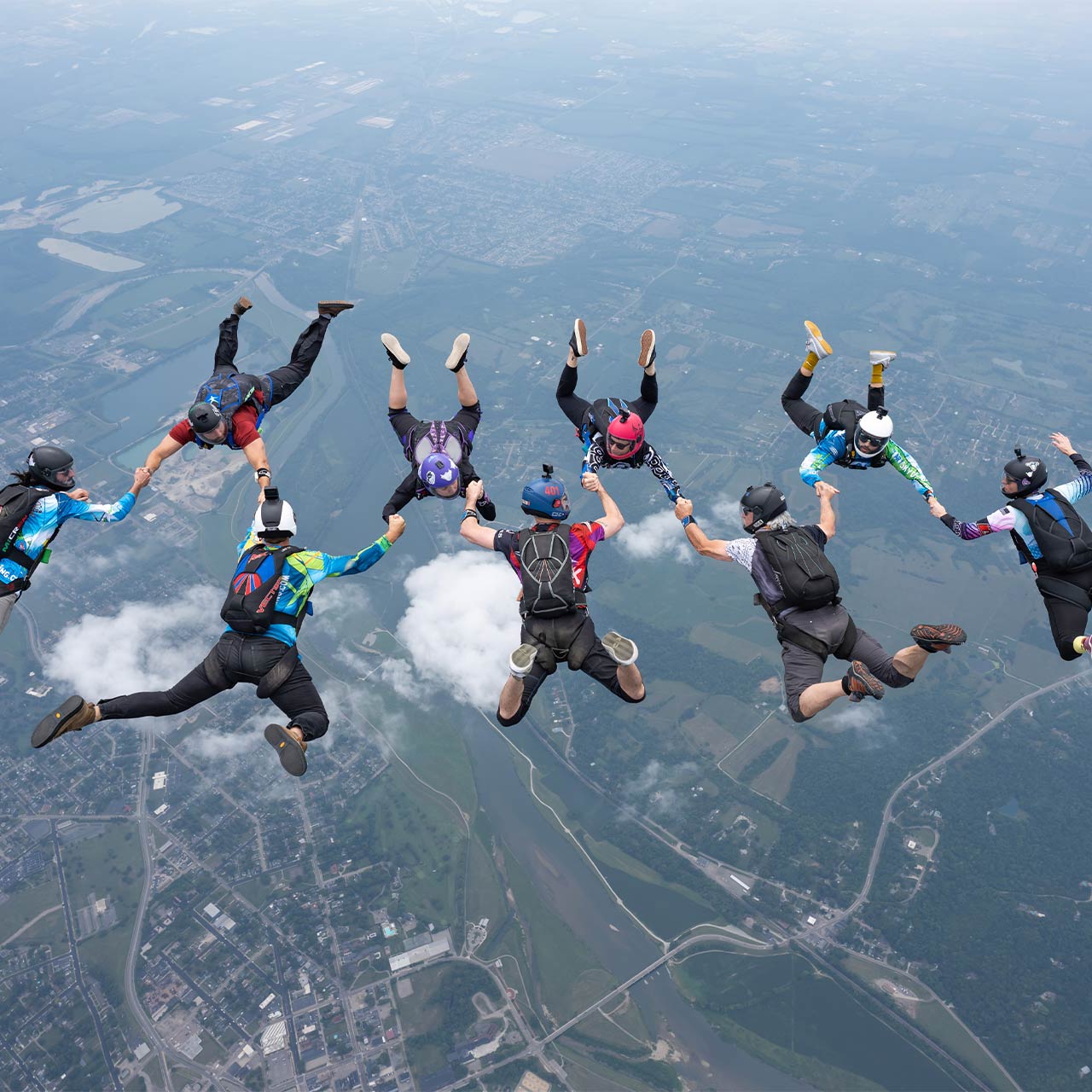
Jump Requirements
All license levels and disciplines are welcome at Start Skydiving. Just be prepared to show your:
-
Current USPA membership and license; military or foreign equivalents can be converted to a USPA license at an Instructor Examiner’s discretion
-
Signed logbook to prove jump currency
-
Reserve packing data card and seal verified at first check-in, if applicable
Manifest
Manifest is physically located in the 1711 Run Way building – but we use Burble and ask that experienced skydivers self-manifest. Place funds on your account at manifest or via the BurbleMe app. We do not carry credit, but we can hold credit cards for the day which we run as soon as 15 minutes after the last load lands if you haven’t settled up by then.
-
Manifest only when you’re ready to jump
-
Missed loads will not be refunded
-
Double manifesting is not permitted (unless DZO approval is given)
-
Be ready at the loading area by your five-minute call
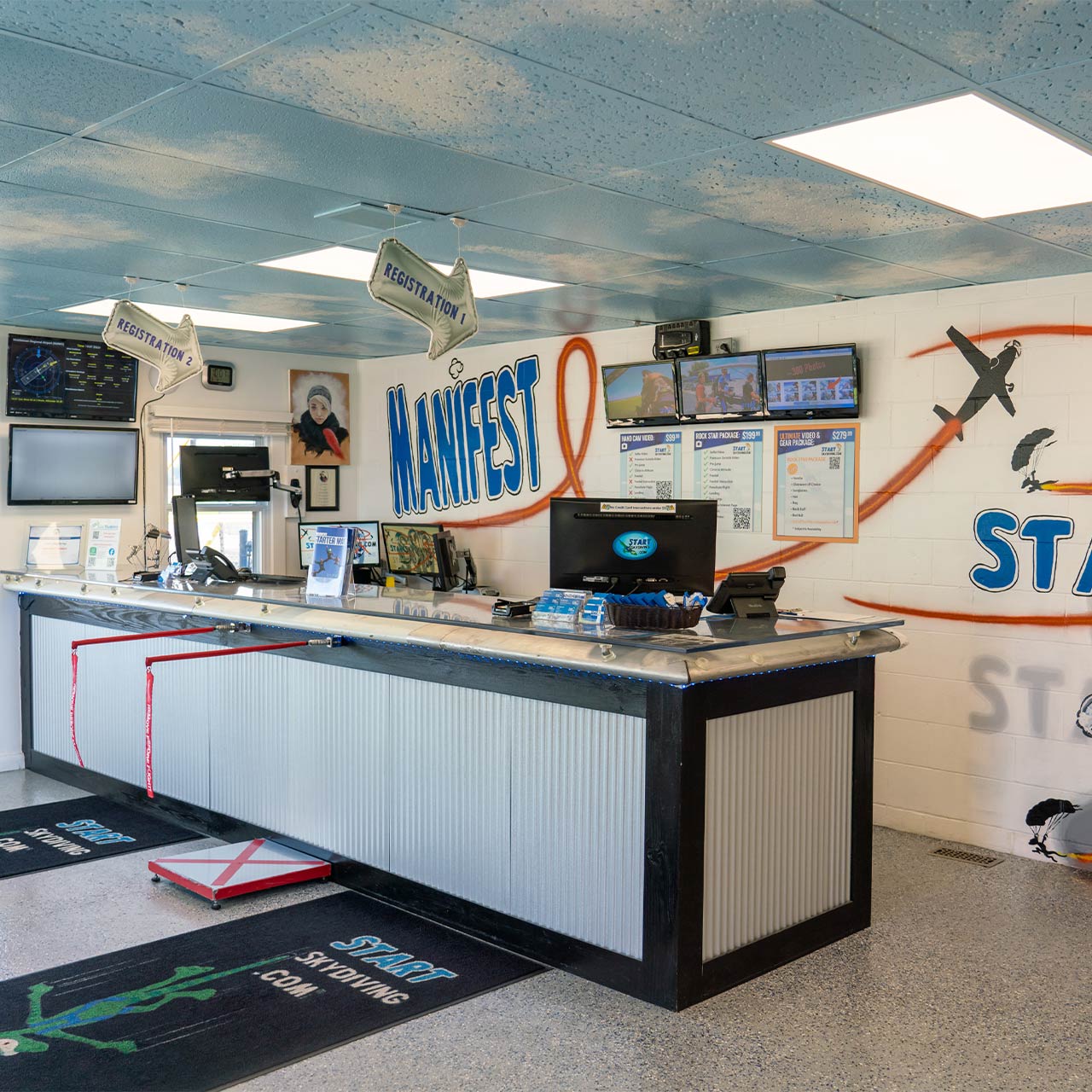
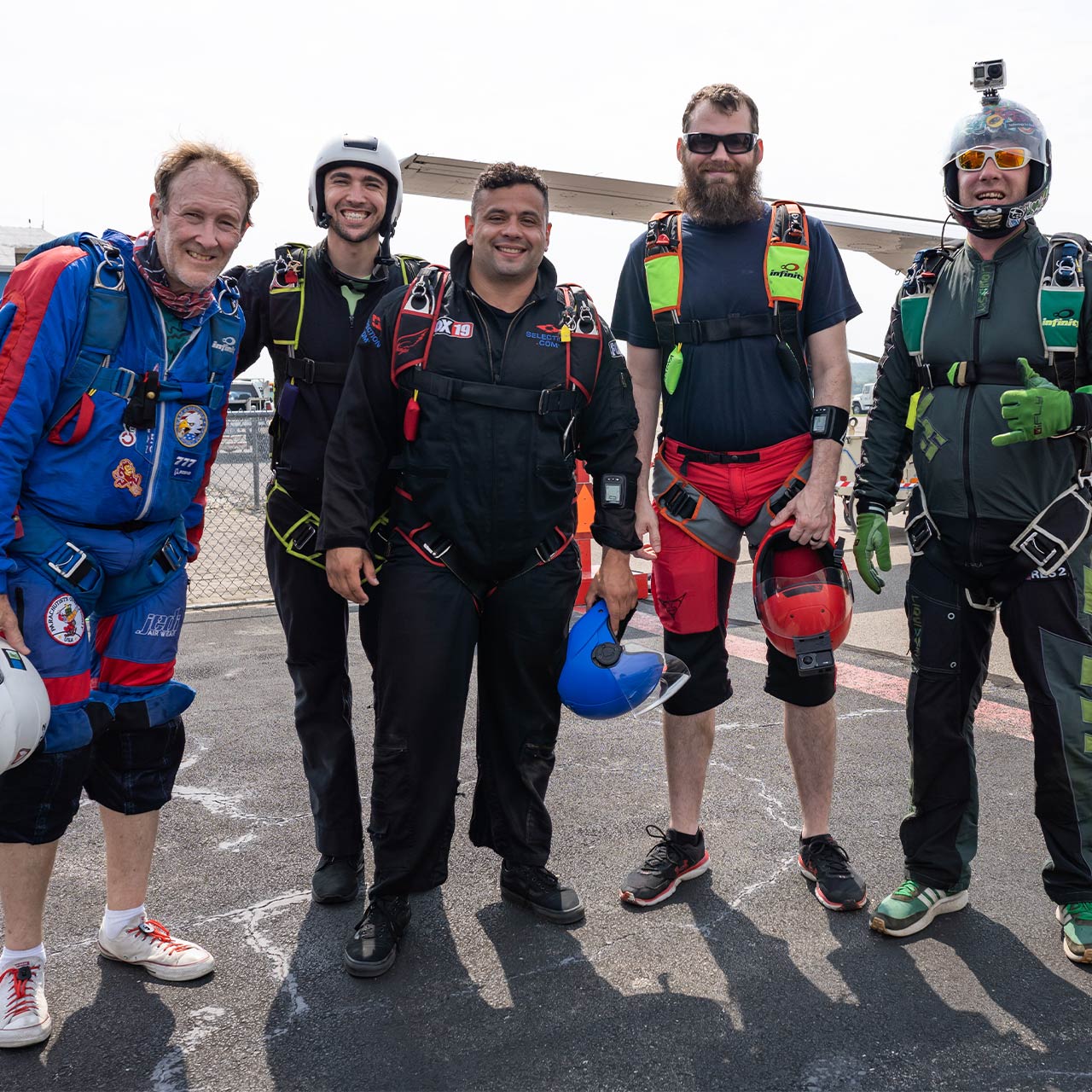
Loading
We have two designated loading areas: Loading Area 1 and Loading Area 2. Be in the boarding area at the five-minute call. Board the aircraft in the opposite order of exit.
Yellow Line
Do not cross the yellow line unless you have:
Any other personnel must be accompanied by authorized Start Skydiving staff.
Red Line
Do not cross the red line until:
Takeoff Requirements
Your rig must be on and ready to jump with your leg straps and chest strap correctly threaded prior to boarding.
-
Helmets and seat belts must be worn until 1,000 feet AGL
-
If you don’t wear your helmet, secure it to your chest strap or seat belt
-
The aircraft door must be closed during takeoff and while below 1,000 feet
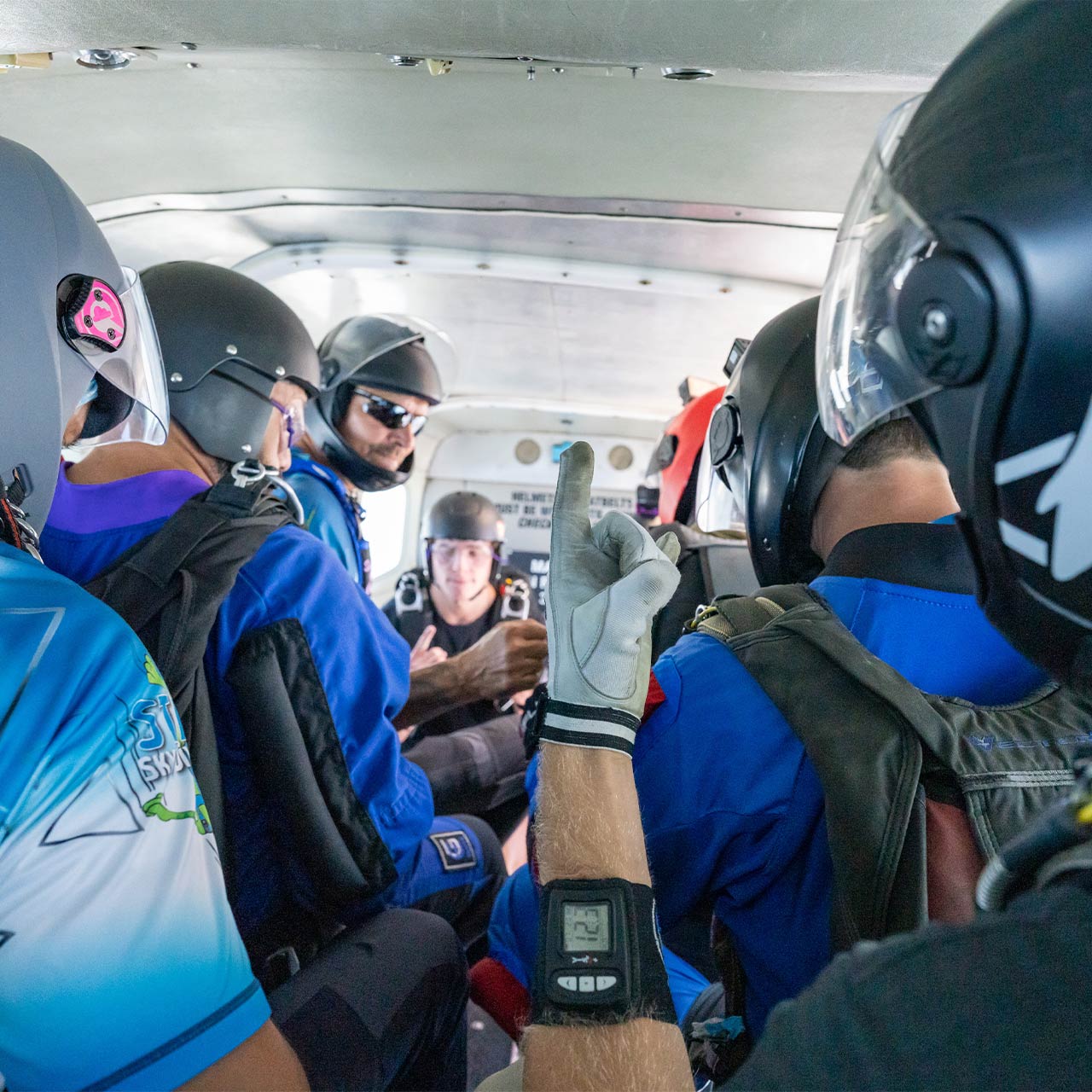
Spotting
Typically, our pilots spot the plane accurately and no corrections are needed. However, you must open the door on the red light and verify that the spot is correct and that the area is clear of aircraft and clouds below before jumping. You must have the pilot’s expressed approval to open the door without a red light.
-
If the spot isn’t correct or if clouds or air-traffic are on jump-run, you are responsible for informing the pilot and must remain inside the aircraft until you’re certain it is clear to exit.
-
When the green light comes on, the pilot has configured the aircraft for safe exit. It does not mean you are clear below or that you are over the correct spot.
-
We’re not legally permitted to perform skydives through clouds. Don’t exit the aircraft unless you know you will not freefall through a cloud.
-
We will do a go-around and fly another jump-run if you cannot exit over the correct spot due to clouds, aircraft, or jumpers.
-
Every jumper is responsible for his or her own safety. This includes checking your spot!
-
All groups should remain forward in the aircraft until it is their turn to exit.
-
If the green light turns off, everyone must stay in the aircraft and wait for another jump run.
Exit Order
1. Low Altitude Clear & Pull Passes
If there are multiple jumpers on the same low pass, exit in order of heaviest to lightest wing-loading.
2. Sky-Surfers
Will receive their own pass to ensure they’re directly over the DZ.
3. Angle Flyers Group 1
4. Belly-Flyer Formation Groups
Includes students on coach jumps. Sort from largest to smallest. Groups of the same size are then sorted from lowest to highest planned deployment altitude. If groups of the same size and deployment altitude, then sort by exit weight and canopy size from least to greatest.
5. “Traditional” Belly Trackers
Note, not angle flyers or tracking suit jumpers.
6. Freeflyer Groups
Sort from largest to smallest. Groups of the same size are then sorted from lowest to highest planned deployment altitude. If groups of the same size and deployment altitude, then sort by exit weight and canopy size from least to greatest.
7. Angle Flyers/Tracking Group 2
8. AFF Students
In the following order: Cat A, B, C-1, C-2, D, E. If multiple AFFs in the same category, then sort by student exit weight and canopy size from least to greatest.
9. Tandems
Tandems with videographers first, then tandems without. Then sort by exit weight and canopy size from least to greatest.
10. Tracking Suit Jumpers
11. Wingsuiters
12. CRW/Flocking (High Pull)
NOTE: Only two groups of either trackers, angle flyers, or wingsuiters are permitted per load. These two groups must fly a pattern with the first leg perpendicular to jump run. The leader of this group must be an experienced jumper who is familiar with the DZ and the airspace. This leader must fly belly-to-earth. If the lead flyer will be back-flying, another experienced jumper must pair with the leader and fly belly-to-earth over the leader to help maintain directional control.
Exit Separation
An exit separation chart is posted by the jump door of each aircraft. This chart shows the minimum amount of time that must be given between solo jumpers based on the ground speed of the aircraft during jump run. Time begins from the moment the previous group has left the plane and includes moving to the door, climbing out, and setting up.
- All groups remain forward (toward the cockpit) until the previous group has exited.
- More time must be allowed between exits before large groups and after freefly groups.
If the ground speed is not attainable, use this general rule of thumb (taking into account the time it takes to climb out of the aircraft) to give you the recommended amount of time between exits: upper headwind speed divided by half (round up for odd numbers).
-
0-10 knots – 5-7 seconds between group exits
-
15-20 knots – 8-10 secs between group exits
-
21-30 knots – 11-15 secs between group exits
-
31-40 knots – 16-20 secs between group exits
-
41-50 knots – 21-25 secs between group exits
Landing Rules
As shown below (and posted around the DZ), there are three primary landing areas and a dozen large outs.
-
Avoid crossing the runway below 1,000 feet
-
Avoid approaching the ends of the runway below 2,000 feet
-
Avoid landing on any runways (inc. grass strip), taxiways, or tarmac
-
Planned landings outside of the designated areas are prohibited
Landing Patterns
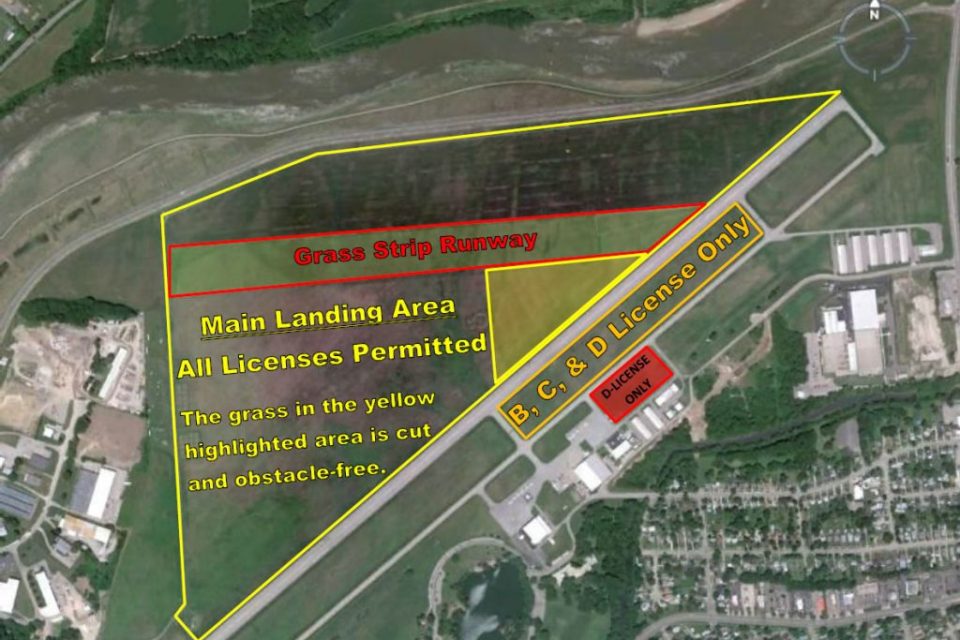
B, C & D License Only
- Based on the current landing direction; posted by the entrance of the loading areas
- If set landing direction is to the southwest (hangars on left), a left-handed landing pattern is required
- If set landing direction is to the northeast (hangars on right), a right-handed landing pattern is required
- There’s no set landing pattern/direction for the large landing area on the northwest side of the runway
- All jumpers must land into the wind; the first jumper down sets the pattern
- If there is no wind, all landing areas default to a southwest landing direction (hangars on left)
- Only 90-degree turns are permitted in all landing areas
- Any turns greater than 90 degrees must be cleared by the S&TA before being performed
Tandem & D License Only
- Located directly in front and to the right of hangar
- Tandems have the right of way; continuously watch for canopy traffic
- D licensed skydivers only to land in this area
- First person down sets the pattern; follow the windsock if you are first to land
- If there is no wind, default to a southwest landing direction (hangars on the left) while flying a left-handed landing pattern
- Only 90-degree turns are permitted in this area
- Any turns greater than 90 degrees must be cleared by the S&TA before being performed
B & C License Only
- Located between the runway and taxiway northeast of the Tandem & D License Only area
- Tandems have the right of way; continuously watch for canopy traffic
- If there is no wind, default to a southwest landing direction (hangars on the left) while flying a left-handed landing pattern
- Only 90-degree turns are permitted in this area
- Any turns greater than 90 degrees must be cleared by the S&TA before being performed
Main Landing Area
- All licenses permitted
- Located in the massive field on the northwest side of the runway
- Use windsock located in the middle of the landing area to determine landing direction
- First person down sets the pattern; follow the windsock if you are first to land
- Tandems and AFF students have the right of way; continuously watch for canopy traffic
- If there is no wind, default to a Northeast landing direction (hangars on the right) while flying a right-handed landing pattern
Frequently Asked Questions
Where is Start Skydiving?
Start Skydiving is conveniently located ~ 15 minutes off of I-75 at Middletown Regional Airport, 1711 Run Way, Middletown, OH 4504. We’re smack dab at the midpoint between Dayton and Cincinnati, right along the beautiful Great Miami River. It’s super easy to get us from most any city within a 300 mile radius of us!
- Dayton, OH – 30 mins
- Cincinnati, OH – 45 mins
- Louisville, KY – 2 hrs 30 mins
- Indianapolis, IN – 2 hrs 10 mins
- Columbus, OH – 1 hr 30 mins
- Lexington, KY – 2 hrs
- Toledo, OH – 2 hrs 30 mins
- Akron, OH – 3 hrs 15 mins
- Cleveland, OH – 3 hrs 30 mins
When are you open?
That all depends on the time of year because, you know, Ohio! We jump until sunset if we have good weather and enough jumpers. We’re always closed on Easter Sunday, Thanksgiving Day, and Christmas Day.
MARCH
- Saturday & Sunday: 8:00 a.m. – Sunset
APRIL
- Monday & Friday: 1:00 p.m.. – Sunset
- Saturday & Sunday: 8:00 a.m. – Sunset
MAY TO SEPTEMBER – SKYDIVING SEASON!
- Monday, Thursday & Friday: 1:00 p.m. – Sunset
- Saturday & Sunday: 8:00 a.m. – Sunset
- Tuesday: Office Closed; No Jumping
- Wednesday: Office Hours 2:00 p.m. – 5:00 p.m. (No Jumping)
OCTOBER
- Monday & Friday: 1:00 p.m. – Sunset
- Saturday & Sunday: 8:00 a.m. – Sunset
NOVEMBER
- Saturday & Sunday: 8:00 a.m. – Sunset
MID-NOVEMBER TO MID-MARCH*
- Saturday & Sunday: 8:00 a.m. – Sunset
- Jumping for licensed skydivers only.
* Jumping for licensed skydivers only. Temperatures must reach at least 40°F on the ground; pilot and staff must be available; and we must have enough jumpers to efficiently send loads. All information ~ off-season jumping is posted on our Licensed Jumpers Facebook page.
Can’t get us on the phone? Leave a voicemail and we’ll return your call as soon as possible, or email us at info@startskydiving.com.
Is there an age requirement to jump at Start Skydiving?
In accordance with a mandate set forth by the United States Parachute Association (USPA), you must be at least 18 years of age in order to skydive at Start Skydiving. Please remember to bring your valid, government-issued, photo ID with you to the dropzone to prove your age and identity. Consent from a parent or guardian will not suffice.
How much does it cost to jump at Start Skydiving?
We offer individual lift tickets and packages of 50 and 100 lift tickets. Check out our Pricing page for details.
Do lift ticket packages expire?
Lift ticket packages must be used by the end of the season during which they were purchased.
What forms of payment do you accept?
We accept American Express, Discover, MasterCard, VISA, and cash. We do not accept checks.
Do you offer gift certificates?
Yes! And they make an amazing gift for birthdays, graduations, anniversaries, and other celebrations. We offer gift certificates for specific experiences – including tandem skydiving, media packages, observer flights, AFF training, and lift tickets – and for Start Bucks, which can be applied to any service at the dropzone. Start Bucks are available in $25, $50, $100, and $200 increments.
Gift certificate purchases are nonrefundable. Check out our Gift Certificates page for more info.
Do gift certificates expire?
Start Skydiving gift certificate values are good for five years from the date of purchase however, any discounted rates are only good for the specified period. If the specified period has expired, the funds can be applied towards the full price of the specific experience. Gift certificates are nonrefundable, but are transferable, and should be treated like cash.
What is your inclement weather policy?
Jump operations are suspended in the event of:
- Strong steady winds or gusts
- Low clouds and fog
- Rain
- Lightning, thunder; storms
- Temperature below 40°F at ground level
- Wind chill factor below -30°F at altitude
For the nitty gritty, check out our Weather Resources page.
Is there space for friends and family to watch me jump?
Yes, we have two large paved patio areas with picnic tables, umbrellas, and lawn chairs, as well as manicured green spaces that are perfect for lounging around. They’ll have a great view of the boarding and landing areas, and will see you overhead as you make your approach for landing.
Encourage your hype crew to pack up their particulars and stay awhile! We recommend that folks bring:
- Camera
- Sunglasses
- Binoculars
- Stereo (clean lyrics and moderate volume, please!)
- Picnic blanket
- Snacks
- Water and drinks (non-alcoholic only; no onsite water fountain)
What amenities are available when I’m not jumping?
Onsite, we have a high ropes course and indoor climbing wall, cornhole, tabletop games, plenty of green space complete with lawn chairs, picnic tables, and shade, an A+ bonfire pit, and free Wi-Fi.
Our campus runs alongside Smith Park, which has a fishing pond, splash pad, playground, and soccer and baseball fields. Plus, you can kayak on the Great Miami River and bike on the Great Miami River Trail (over 75+ miles long!). And when your adventures work up your appetite, there are several restaurants and hotels less than half of a mile away!
Are there places to eat, drink, and pick up supplies near the dropzone?
There are several restaurants, bars, and grocery stores near Start Skydiving. Take your pick, or ask us for a recommendation.
Can I stay at the dropzone?
Yes! 5 Minute Call is a shared lodging rental within a one minute walk to the dropzone and just seven minutes to multiple restaurants. Wait out the weather or relax between jumps – there’s a Burble Manifest display in the kitchen!
We also have a campground for tent camping. Call for availability.
Can I bring my dog with me to the dropzone?
Service dogs are welcome at Start Skydiving. For safety reasons, pet dogs are not allowed at the dropzone.
Can I wear my own camera on my skydive?
According to the Basic Safety Regulations (BSRs) mandated by the United States Parachute Association (USPA), you have to be a USPA C licensed skydiver with at least 200 skydives to wear any camera gear on your person or equipment.
No exceptions.
Can I walk on the tarmac?
No. No one is permitted on a tarmac unless they are being escorted by authorized Start Skydiving staff to board an aircraft. You must stay in the grass and enter through the gate by the D-license landing area. When walking back in the grass, keep your head up and watch for other jumpers who may be landing and aircraft that may be taxiing.
How do I cross the runway/taxiway if I land in the A-license and student landing area?
The preferred method of crossing the runway and taxiway is via our recovery vehicle. We try our best to pick up all jumpers that land in the A-license and student landing area within five minutes of jumpers landing. If the vehicle does not pick you up promptly, use the two-way radio located in the orange barrel and call manifest to request a ride. If there is no response, you may cross using the following procedures:
- Before crossing a runway/taxiway on foot, stop 50 feet away and wait for all jumpers that need to cross. While waiting, listen and look – both ways multiple times – on the ground and in the air for incoming aircraft.
- If an aircraft is about to takeoff, land, or taxi by, back away (200 feet from the runway, 50 feet from the taxiway) and kneel on the ground while maintaining eye contact with the aircraft until it has cleared the runway/taxiway. This signals to the pilot that you see the aircraft and won’t cross in front of it.
- All jumpers must cross quickly as a group while staying vigilant and watching for incoming aircraft in the air and on the ground. This makes jumpers more noticeable to aircraft, helps reduce the number of crossings, and cuts time spent on the runways/taxiways.
What’s required to get the USPA A License, and what can I do with it?
Following comprehensive training – such as the AFF program at Start Skydiving’s Jump Institute, you must fulfill the following criteria to earn the USPA A License:
- Log at least 25 jumps
- Perform five group freefall skydives involving at least two participants
- Pass oral and written exams
- Complete all requirements listed on the USPA A License Proficiency Card
- Earn the signature and official stamp on the Proficiency Card
- Mail your completed Proficiency Card to the USPA, officially join the organization, and get your license number
USPA A license holders can jump without supervision, pack their own main parachute, engage in basic group jumps, and perform water jumps.
For more information, see the USPA Skydiver’s Information Manual (SIM) Section 3.
What’s required to get the USPA B License, and what can I do with it?
Progressing to the USPA B License requires that you:
- Hold a USPA A license
- Complete at least 50 jumps, including:
- Accumulate at least 30 minutes of controlled freefall time
- Land within 33 feet of target center on 10 jumps
- Successfully complete planned formation(s) on 10 formation skydives, or 10 formation freefly skydives, at least five of which, in either discipline, must involve at least three participants
- Document live water landing training with full equipment
- Complete all requirements listed on the USPA Canopy Piloting Proficiency Card
- Pass a written exam
USPA B License holders can exercise all privileges of an A License holder, perform night jumps, and, with 100 jumps, are eligible for the USPA Coach Rating.
For more information, see the USPA Skydiver’s Information Manual (SIM) Section 3.
What’s required to get the USPA C License, and what can I do with it?
Progressing to the USPA C License requires that you:
- Hold a USPA B License
- Complete at least 200 jumps, including:
- Accumulate at least 60 minutes of controlled freefall time
- Land within seven feet of target center on 25 jumps
- Successfully complete 50 formation skydives, or 50 formation freefly skydives, at least 10 of which, in either discipline, must involve at least four participants
- Pass a written exam
USPA C License holders can exercise all privileges of a B License holder, are eligible for the USPA Instructor rating (except USPA Tandem Instructor), participate in certain demonstration jumps, and may ride as a passenger on USPA Tandem Instructor training and rating renewal jumps.
For more information, see the USPA Skydiver’s Information Manual (SIM) Section 3.
What’s required to get the USPA D License, and what can I do with it?
Progressing to the USPA D License requires that you:
- Hold a USPA C license
- Complete at least 500 jumps, including:
- Accumulate at least three hours of controlled freefall time
- Complete at least two of the following skills requirements (may be repeated):
- Land a night jump within seven feet of the target center on 100 jumps
- Participate in a canopy formation of a 3 stack or larger, completing a full rotation
- Complete an intentional water jump
- Successfully complete 100 formation skydives, at least 25 of which must involve at least eight participants
- Pass a written exam
USPA D License holders can exercise all privileges of a C-license holder and are eligible for all USPA ratings.
For more information, see the USPA Skydiver’s Information Manual (SIM) Section 3.
What ratings can I pursue and how do I earn them?
After completing 100 jumps as B License holder, the first rating you can pursue is the USPA Coach Rating. Coaches can teach the fundamentals of skydiving in the First Jump Course, train solo students on the ground, and make Coach jumps with them in the sky.
USPA C and D License holders are eligible to apply for USPA Instructor Ratings, including AFF Instructor and IAD/Static Line Instructor Ratings. D License holders are eligible to apply for the Tandem Instructor Rating and PRO Rating.
For more information, see the USPA Instructional Rating Manual (IRM) and Skydiver’s Information Manual (SIM). Interested in earning an instructor rating? Call the dropzone or email us to schedule your Instructor Rating Course.
What’s required to get the USPA PRO Rating, and what can I do with it?
To earn the USPA PRO Rating, USPA D licensed skydivers must demonstrate landing skills with the parachute they plan to use for shows and receive training on using flags and pyrotechnics.
PRO Rating holders are permitted by the Federal Aviation Administration to fly and land closer to crowds than jumpers who have not demonstrated these qualifications. PRO Rating holders perform skydiving exhibitions or demonstrations, typically landing in challenging areas.
For more information, see the Skydiver’s Information Manual (SIM), Section 7.
What is Team Fastrax™?
Team Fastrax™ is the largest professional parachute demonstration team in the world. The team roster has more than 40 active members, many of whom are veterans of the Armed Forces, with 175,000 skydives collectively. Team Fastrax™ has performed exhibition jumps into highly-restricted airspace in a number of countries, including in Russia, Qatar, China, France.
Team Fastrax™ exclusively trains at Start Skydiving. Watch them jump at the dropzone, and reach out to the Team to connect with Load Organizers and receive free coaching – both incredible opportunities that you should definitely explore.